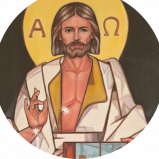The Catholic way of interpreting Sacred Scripture is based on the idea that the salvific events recounted in the Gospels are foretold in the Old Testament, and the New Testament revels the prophecies contained in the Old Covenant. This is called TYPOLOGY, where the Old Testament figure is the TYPE and the revealed reality is called the ANTITYPE. So in today’s first reading the bronze serpent raised on a pole that heals those doomed do die from the bite of the serpents is the TYPE, and Jesus lifted up on the cross for our salvation is the ANTITYPE.
In like manner when we see serpents showing up in Scripture we can immediately make the cognitive leap back to the events in the Garden of Eden in which the serpent through envy prompted our first parents’ dissatisfaction with their situation which led them to betray their relationship with God and join the devil’s rebellion. It was at that point that sin and death entered the world and ruined the perfect innocence of creation for all subsequent generations. Even in that catastrophic moment God promised a savior, He would not permit the tragedy to continue forever.
So when the people complained about their situation God sent saraph serpents to remind them, first, that rebellion has consequences and second that His love and concern were still with them. So He had Moses fashion a bronze serpent, mount it on a pole that the people dying of the bite of the serpent might be saved. The very thing that was killing them had become the sign that effected their healing.
In the Gospel Jesus himself points out that just as the serpent was lifted up in the desert so he would be lifted up for our salvation. In this he will be fulfilling the words of the prophet Zechariah, “They shall look upon him whom they have pierced,” as recalled later in the Gospel at Jesus’ crucifixion.
<img class=”aligncenter size-large wp-image-77″ src=”https://svdp90042.org/wp-content/uploads/2025/09/artspace-ai-1757535191201-768×1024.png” alt=”” width=”768″ height=”1024″ />Jesus, whose name means “Salvation”, took the role of the serpent so that “For our sake [God] made him to be sin who knew no sin, so that in him we might become the righteousness of God.” Jesus enters fully into our experience of sin and death that he might embrace humanity’s rebellion and all its consequences, take it all onto himself and overturn it at its roots.
In today’s Gospel Jesus says, “everyone who believes in him (speaking of himself in the third person) may have eternal life.” When Jesus says BELIEVE he’s not talking about a notional assent to an intellectual proposition. He’ talking about the kind of visceral belief that guides our life. It is the kind of belief that a drowning man has that if he can get his head above water he will be able to breathe and live, so he bends his every effort to achieve that goal.
He goes on to say, “that anyone who believes in him (Jesus) might not perish.” A better word than ‘perish’ is ‘be destroyed’. As in obliterated, the way Sodom and Gomorrah were destroyed. An interesting archaeological note: in the place where Sodom and Gomorrah used to be excavations reveal that the ground was fused into glass, including one side of the remains of walls. This is the same phenomena observed at nuclear blast sites.
Jesus initiates his Kingdom by triumphing over the devil on the cross. The cross was for Jesus and is for us the gateway to the Resurrection. Our Protestant brethren criticize us for constantly depicting Jesus on the cross. They say that the bare cross is the symbol of the resurrection. This is incorrect, the empty tomb is the symbol of the resurrection.
Jesus’ great victory over sin and death was won precisely by hanging on the cross, a fact of faith we dare not forget. Saint Paul himself says, “For I decided to know nothing among you except Jesus Christ and him crucified.” This is why the crucifix – a cross with the body of Jesus hung on it – is the principal ornament of every Catholic church. This is why the entrance and exit processions at Mass are always led by Jesus Christ and him crucified raised high and going before, the standard of our God and King. This is so that we may raise our eyes and look upon him whom our sins have pieced, that we might recall our allegiance to him, and renew it as we do at every Mass.
<p style=”text-align: center;”><strong>We adore you, O Christ, and we bless you,</strong>
<strong>because by your Cross you have redeemed the world.</strong></p>
<a href=”https://rumble.com/v6yyevg-the-triumph-of-the-holy-cross.html”>Video presentation</a>
![]()
